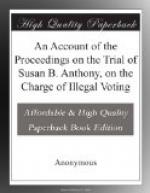In accordance with these provisions, I insist that in every criminal case, where the party has pleaded not guilty, whether upon the trial the guilt of such party appears to the Judge to be clear or not, the response to the question, guilty or not guilty, must come from the jury, must be their voluntary act, and cannot be imposed upon them by the Court.
No opportunity has been given me to consult precedents on this subject, but a friend has referred me to an authority strongly supporting my position, from which I will quote, though I deem a reference to precedents unnecessary to sustain the plain declarations of the Constitution: I refer to the case of the State vs. Shule, (10 Iredell, 153,) the substance of which is stated in 2 Graham & Waterman on New Trials, page 363. Before stating that case I quote from the text of G. & W.
“The verdict is to be the result of the deliberation of the jury upon all the evidence in the case. The Court has no right to anticipate the verdict by an expression of opinion calculated so to influence the jury as to take from them their independence of action.”
In the State vs. Shule, two defendants were indicted for an affray. “The jury remaining out a considerable time, at the request of the prosecuting attorney they were sent for by the Court. The Court then charged them that although Jones, (the other defendant,) had first commenced a battery upon Shule, yet, if the jury believed the evidence, the defendant, Shule, was also guilty. Thereupon, one of the jurors remarked that they had agreed to convict Jones, but were about to acquit Shule. The Court then charged the jury again, and told them that they could retire if they thought proper to do so. The jury consulted together a few minutes in the Court room. The prosecuting attorney directed the clerk to enter a verdict of guilty as to both defendants. When the clerk had entered the verdict, the jury were asked to attend to it, as it was about to be read by the clerk. The clerk then read the verdict in the hearing of the jury. The jury, upon being requested, if any of them disagreed to the verdict to make, it known by a nod, seemed to express their unanimous assent; and no juror expressed his dissent.” In reviewing the case the Court say: “The error complained of is, that before the jury had announced their verdict, and in fact after they had intimated an intention to acquit the defendant, Shule, the Court allowed the clerk to be directed to enter a verdict finding him guilty, and after the verdict was so entered, allowed the jury to be asked if any of them disagreed to the verdict which had been recorded by the clerk. No juror expressed his dissent; but by a nod which appeared to be made by each juror, expressed their unanimous assent. The innovation is, that instead of permitting the jury to give their verdict, the Court allows a verdict to be entered for them, such as it




